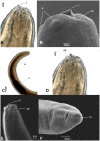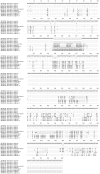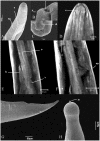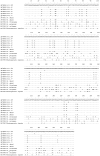Morphological and molecular diagnosis of anisakid nematode larvae from cutlassfish (Trichiurus lepturus) off the coast of Rio de Janeiro, Brazil
- PMID: 22792329
- PMCID: PMC3392247
- DOI: 10.1371/journal.pone.0040447
Morphological and molecular diagnosis of anisakid nematode larvae from cutlassfish (Trichiurus lepturus) off the coast of Rio de Janeiro, Brazil
Abstract
Anisakid nematode larvae from Trichiurus lepturus off coast of Rio de Janeiro were studied using light, laser confocal and scanning electron microscopy, in addition to a molecular approach. Mitochondrial cytochrome c-oxidase subunit 2 (mtDNA cox-2), partial 28S (LSU) and internal transcribed spacers (ITS-1, 5.8S, ITS-2) of ribosomal DNA were amplified using the polymerase chain reaction and sequenced to evaluate the phylogenetic relationships between the nematode taxa. The morphological and genetic profiles confirmed that, of the 1,030 larvae collected from the 64 fish examined, 398 were analysed, of which 361 were Hysterothylacium sp. and 37 were Anisakis typica. Larvae of Hysterothylacium sp. were not identified to the species level due to the absence of similar sequences for adult parasites; however, the ITS sequence clustered in the phylogenetic tree with sequences of H. deardorffoverstreetorum, whereas an mtDNA cox-2 and LSU concatenated phylogenetic analysis demonstrated the presence of two clades, both of them under the same name as the larval H. deardorffoverstreetorum. Data on the occurrence of parasites during the winter and summer months were compared using the t-test. The greatest prevalence and intensity of infection were recorded for larval Hysterothylacium, with a prevalence of 51.56% and an intensity of up to 55 parasites per fish. The larval Anisakis exhibit a higher abundance and intensity of infection in the winter months, and those of Hysterothylacium during the summer. However, the t-test indicated no significant differences between the abundance and intensity of infection recorded during the months of collection for either of these larval nematodes. All sequences generated in this study were deposited in GenBank.
Conflict of interest statement
Figures











Similar articles
-
Molecular and Morphological Characterization of Anisakid Nematode Larvae from the Sandperches Pseudopercis numida and Pinguipes brasilianus (Perciformes: Pinguipedidae) off Brazil.J Parasitol. 2015 Aug;101(4):492-9. doi: 10.1645/14-625.1. Epub 2015 Apr 17. J Parasitol. 2015. PMID: 25885554
-
Molecular characterization of anisakid nematode larvae from 13 species of fish from Western Australia.Int J Food Microbiol. 2013 Feb 15;161(3):247-53. doi: 10.1016/j.ijfoodmicro.2012.12.012. Epub 2012 Dec 28. Int J Food Microbiol. 2013. PMID: 23353682
-
Anisakid nematodes in beaked redfish (Sebastes mentella) from three fishing grounds in the North Atlantic, with special notes on distribution in the fish musculature.Vet Parasitol. 2015 Jan 15;207(1-2):72-80. doi: 10.1016/j.vetpar.2014.11.017. Epub 2014 Nov 25. Vet Parasitol. 2015. PMID: 25498327
-
Infection levels and diversity of anisakid nematodes in blackspot seabream, Pagellus bogaraveo, from Portuguese waters.Parasitol Res. 2012 May;110(5):1919-28. doi: 10.1007/s00436-011-2718-4. Epub 2011 Dec 6. Parasitol Res. 2012. PMID: 22139402
-
Parasites as biological tags in population studies of demersal and pelagic fish species.Parassitologia. 2006 Jun;48(1-2):23-5. Parassitologia. 2006. PMID: 16881389 Review.
Cited by
-
Morphology and molecular characterization hold hands: clarifying the taxonomy of Hysterothylacium (Nematoda: Anisakidae) larval forms.Parasitol Res. 2016 Nov;115(11):4353-4364. doi: 10.1007/s00436-016-5221-0. Epub 2016 Aug 10. Parasitol Res. 2016. PMID: 27511367
-
Anisakis Nematodes in Fish and Shellfish- from infection to allergies.Int J Parasitol Parasites Wildl. 2019 Jun 6;9:384-393. doi: 10.1016/j.ijppaw.2019.04.007. eCollection 2019 Aug. Int J Parasitol Parasites Wildl. 2019. PMID: 31338296 Free PMC article. Review.
-
Morphological and Molecular Characteristics of Anisakis typica Larvae in Two Species of Threadfin Bream, Nemipterus hexodon and N. japonicus, from the Gulf of Thailand.Korean J Parasitol. 2020 Feb;58(1):15-25. doi: 10.3347/kjp.2020.58.1.15. Epub 2020 Feb 29. Korean J Parasitol. 2020. PMID: 32145723 Free PMC article.
-
Diatoms-endoparasite association in fish from the marine pacific coast of Colombia (Buenaventura).PLoS One. 2024 Dec 27;19(12):e0312015. doi: 10.1371/journal.pone.0312015. eCollection 2024. PLoS One. 2024. PMID: 39729457 Free PMC article.
-
3D Reconstruction of Lipid Droplets in the Seed of Brassica napus.Sci Rep. 2018 Apr 26;8(1):6560. doi: 10.1038/s41598-018-24812-2. Sci Rep. 2018. PMID: 29700334 Free PMC article.
References
-
- Mattiucci S, Nascetti G. Advances and trends in molecular systematics of anisakid nematodes, with implications for their evolutionary, ecology and host-parasite co-evolutionary processes. Rollinson D, Hay SI, editors. Academic Press. 2008;66:47–148. editors. Advances in Parasitology. - PubMed
-
- Klimpel S, Palm HW. Anisakid nematode (Ascaridoidea) life cycles and distribution. Increasing zoonotic potential in the time of climate change? Parasitology Research Monographs. 2001;2:201–222.
-
- Anderson RC. Nematode parasites of vertebrates: Their development and transmission. Wallingford: CABI Publishing. 672 p. 2000.
-
- Mattiucci S, Nascetti G, Cianchi R, Paggi L, Arduino P, et al. Genetic and ecological data on the Anisakis simplex complex with evidence for a new species (Nematoda, Ascaridoidea, Anisakidae). Journal of Parasitology. 1997;83:401–416. - PubMed
-
- Nadler SA, D’Amelio S, Dailey MD, Paggi L, Siu S, et al. Molecular phylogenetics and diagnosis of Anisakis, Pseudoterranova, and Contracaecum from northern Pacific marine mammals. Journal of Parasitology, 91. 2005;(6):1413–29. - PubMed
Publication types
MeSH terms
Substances
LinkOut - more resources
Full Text Sources
Molecular Biology Databases
Research Materials

